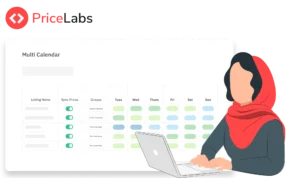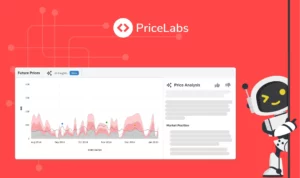Updated: November 17, 2023
As we approach the final stretch of 2023, it’s the perfect moment to reflect on the strides we’ve taken and gear up for the upcoming year. PriceLabs is here to guide you by harnessing last year’s learnings to enter the new year with renewed energy and wisdom. This theme of learning from the past and excitement for the future runs through this month’s product updates. Read on to know more.
In this article, if you have not migrated already, we’ll give you a step-by-step guide to migrate to the new dynamic pricing algorithm, Hyper Local Pulse (HLP). We’ll look at how to optimize Orphan or booking gaps, now with improved settings. We also discuss helpful enhancements to keep track of your past prices and compare them with future prices and the market. Plus, multiple announcements are in store to help you prepare well for the upcoming year.
Migration to the new dynamic pricing algorithm (HLP) is now open to everyone
Why migrate to the new algorithm?
- We are confident that our updated algorithm, Hyper Local Pulse (HLP), will enhance your business’s revenue potential by aligning more precisely with your local market. Evidence from our trials suggests that the new methodology can improve revenues by an additional 9% compared to our previous model.
- Furthermore, all future innovative features related to pricing will be exclusively available through this new algorithm. If you’re using HLP, your listings will also benefit from our market-driven discounts and premiums for last-minute and far-out prices. Don’t overlook these enhancements as they are specifically designed to propel your business growth.
When and how to migrate?
- If you created a PriceLabs account after July 6, 2023, you already use HLP.
- Some of our existing users have been transitioned to Hyper Local Pulse following an evaluation by our data science team. These users have been notified through email and within the product. If you want to know which version of the algorithm you’re running, here’s how to do it.
- To migrate, follow the instructions in the below knowledge base articles. Depending on your former settings, some adjustments might be necessary for the transition to HLP, and we’re committed to making this as seamless as possible. Find out more details on what to expect from the migration here.
Read our Knowledge Base article for more information:
- For accounts with less than 10 listings – Migrating to Hyper Local Pulse (less than 10 listings) OR Watch this video
- For accounts with more than 10 listings: Migrating to Hyper Local Pulse (more than 10 listings)
12 Days of PriceLabs Cheer: Master PriceLabs’ Dynamic Pricing tool (For Hosts & Managers) – Don’t miss it!
Unlock the Power of PriceLabs
Join our 12-day educational series in December 2023 for quick, insightful 20-minute sessions split into 5 minutes of content followed by a 15-minute Q&A where we answer YOUR questions. This series is dedicated to hosts and managers with fewer than 5 properties. Don’t miss out on this valuable opportunity – click to sign up now! Please register below to make sure your 2024 pricing is in order.
Master your booking gaps with improved Orphan Gap Functionality
Unoccupied days between bookings are known as an orphan gap or “booking gaps”. These gaps can be intentional or unintentional, resulting from cancellations or a lack of demand. For vacation rental property owners and managers, orphan gaps can result in lost revenue and increased operational costs. Not only does the vacation rental sit empty, but additional expenses are associated with cleaning and maintaining the vacation rental during these periods.
Therefore, owners and managers must develop strategies to mitigate orphan gaps and maximize revenue. Optimizing orphan gaps reduces the need for last-minute discounts, allows for better planning, and ensures a more consistent flow of guests.
What’s new with Orphan Gaps & Price Customizations
We’ve updated our orphan gap customizations to give you more flexibility in setting minimum stay requirements for short gaps between reservations, depending on the booking window. Previously, our settings only allowed for Orphan Gap rules to be set up for different gap lengths. But now, you can tailor minimum stay rules for gaps of the same length but apply different rules based on how far out the gap is.
The screenshot below shows the application of this feature (for illustrative purposes).
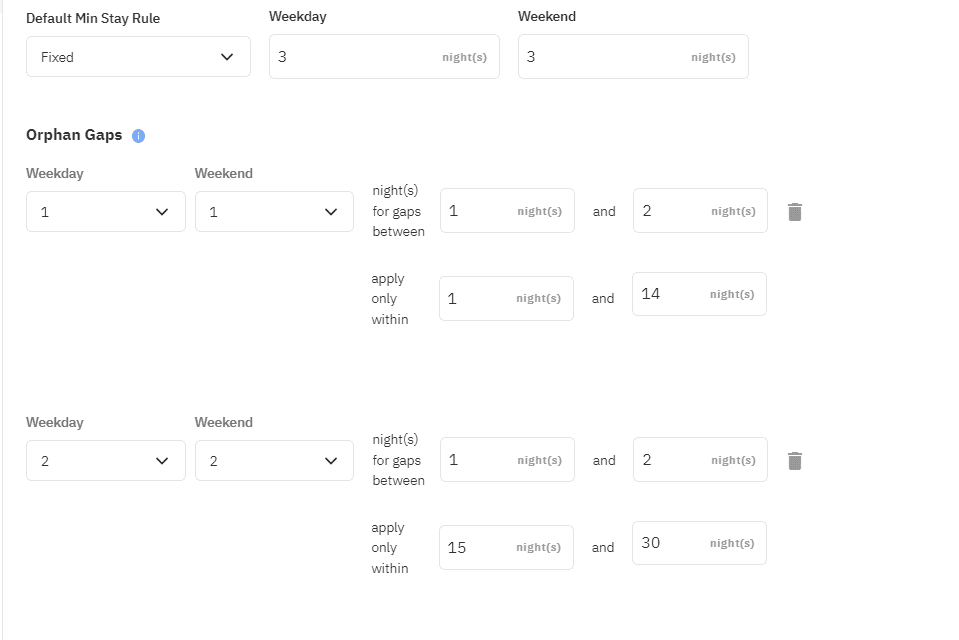
In this example,
- Within the next 14 days: For orphan gaps of 1 or 2 nights, you allow a minimum stay of 1 night
- Between 15 to 30 days out: For similar gaps of 1 or 2 nights, you can set a slightly longer minimum stay requirement, or set “Length of Gap” as minimum
- Beyond 30 days: In this booking window, your standard minimum stay, here 3 nights, will apply by default for any orphan gaps
This update gives you the flexibility to adapt your booking strategy according to different time frames, maximizing occupancy and catering to varying guest needs. You can use this feature under the ‘Orphan Gaps‘, ‘Customize Orphan Gap Prices‘, and ‘Adjacent Day before/after an unavailable night‘ settings.
Find out how pricing recommendations have changed with Price Evolution data
Our Daily Updated Pricing Strategy:
At PriceLabs, we are dedicated to providing the most up-to-date pricing recommendations. Each day, we analyze the market to suggest new prices for each upcoming day. This ensures that our recommendations are always aligned with the latest market trends and demands.
The suggested prices for a specific future date are not set in stone; they can change daily. We continuously monitor and adjust our prices in response to changing demand. As a result, the price recommendation for a particular date may differ from one day to the next, reflecting our commitment to staying current with market conditions.
Introducing the Price Evolution Data:
We understand that our users are interested in more than just the current price recommendations. Many wish to see how our past recommendations compare with the present.
To accommodate this, we now offer the ability to view what prices we suggested 1, 2, 7, or even 30 days ago for any future date. Our long-term users will be able to see the prices that were suggested at the same time last year which can be convenient when looking at the price recommendations we are making for 2024 and see what we recommended in 2023.
You can view this by checking the “Show Price Evolution” box under the More Options button in the Future Prices chart, under the Neighborhood Data tab. This feature helps users understand the evolution of our pricing recommendations. With this, users can track the prices we recommended in the past, offering a clear view of how our price suggestions have changed over time. This not only provides valuable insights into your property’s pricing trends but also demonstrates our commitment to transparency and user empowerment in pricing decisions.
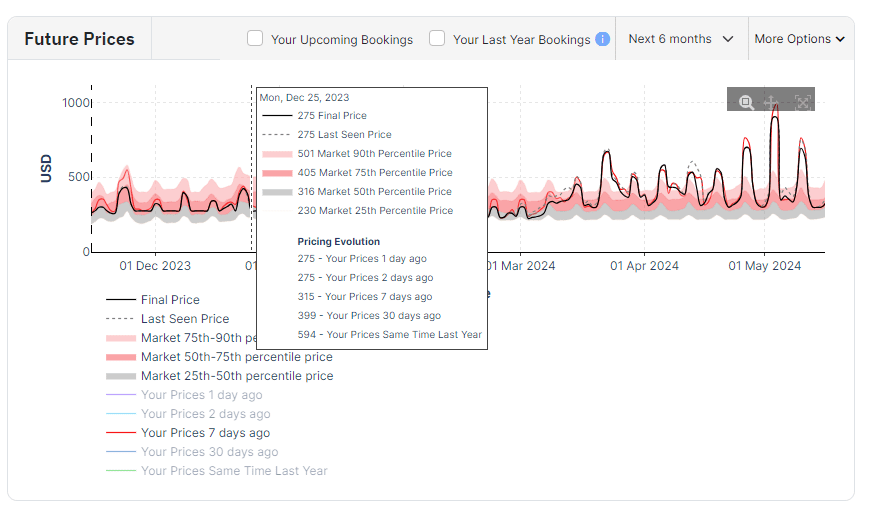
Get a better sense of how your portfolio is pacing
The Pacing chart in Portfolio Analytics gives insights into your booking rate against a benchmark, like last year or the market. You can gauge whether your portfolio is lagging or in line with previous trends. This tool also shows last year’s final market occupancy rate, indicating the proportion of market inventory sold.
We have updated the existing interface in the Pacing chart. Filters are now visible easily to view the data from the past month, 3 months, 6 months, or 1 year. You can also choose to aggregate this data on a daily, weekly, or monthly basis, depending on your requirements. Also, tick the “Remember selection” checkbox to save the filter selections for your next visit.
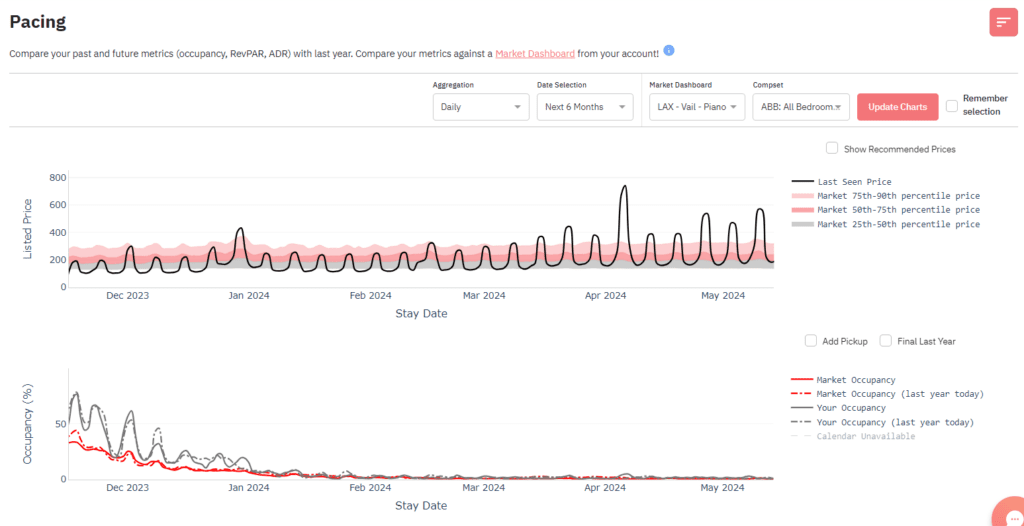
PriceLabs connects with 3 more PMSs
Here are the 3 PMSs joining our list of 100+ integrations:
- RoomAdmin
- Shopbnb
- RentalWise
Bonus: Takeaways from VRMA
The PriceLabs team was part of the recently concluded VRMA International Conference 2023. The event, held in Orlando, gathered vacation rental professionals to discuss industry trends and challenges. With over 2,500 attendees and 100 vendors, the event covered topics from data trends to sustainability and the rise of smaller OTAs. Read more in our blog.






